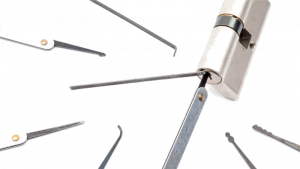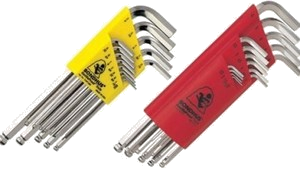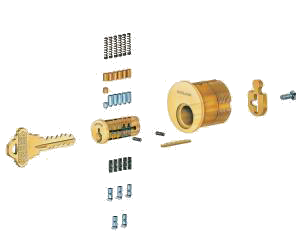A (very) brief background on locksmiths
Locksmithing is considered one of the “traditional trades” (like masonry, carpentry and blacksmithing, for example) which has been in practice for hundreds of years.
In addition to opening locked doors or stubborn locks, the locksmiths at Aim Lock & Safe are also involved in a variety of facets as it relates to lock installation and repair:
- Lock specialization (i.e. for cars, master key systems, cabinetry or even handcuffs and jail cells)
- Electronic locks (i.e. making transponder keys or implementing keyless entry systems)
- Home & Commercial Safe technicians (i.e. installing or resetting digital or manual combination locks)
Picking tough locks open
However, the bread-and-butter of any locksmith is to help pick open those stubborn locks by using a myriad of tools and gadgets at their disposal.
While the construction and materials used in these tools have improved over time, the basic design and function of locksmith tools have stayed relatively the same.
Let’s take a look inside the locksmith’s tool bag and understand what common tools they use to help open your door when you’re locked out.

Trip wire
A trip wire is a curved tool which every locksmith must have for any job.
It’s primarily used to open frozen tumblers (the pins inside a door lock with line up perfectly with the key made to open it).
Here’s how a trip wire works:
- The locksmith inserts the end of the trip wire into the keyhole
- Holding the tool with one hand, he turns the knob with the other and opens the door
Trip wires are usually made from high-grade steel and are razor thin, so they can fit into any sized keyway. As well, they’re tough enough to keep their shape after many repeated uses.

Hex keys
Hex keys (also known as Allen keys) can be picked up any hardware store in Milton, Hamilton or surrounding areas, so they’re not necessarily restricted to locksmiths.
However, the way locksmiths use hex keys when you’re locked out are quite different than how you would use them on a daily basis.
That’s because many locksmiths take their hex keys and grind down the end of the key, so that hexagonal shape becomes a “U” – with two raised edges and a groove in the middle.
Why do they do this?
Because sometimes, if a trip wire won’t work, the locksmith will insert the modified hex key into the keyhole to try to open it as if it were the actual key to the lock.

Plastic shims
Flexible plastic shims (also known as bypass shims) are used to help with door latches.
They can easily slide between any locked door and door frame, wall frame or doorjamb without cracking or breaking.
Shims aren’t necessarily big (they are usually rectangular in shape or about 6”x6” square) and can open just about any spring-powered latch bolt.
In addition to doors, locksmiths can use plastic shims to open window latches too.
See our locksmith tools in action (if you need us)
It’s never fun being locked out of your home, car or home safe.
If that happens to you, don’t panic and don’t try to compromise the lock yourself. Give us a call instead.
We’ll be over as quickly as possible with our bag of tools (some of which you’ve just read about), ready to use them to give you the access you need – fast.
We’ve been locksmithing since 1986, carrying on a proud, and centuries old trade.
Speak with an experienced locksmith today, and let us know exactly how we can help you.








